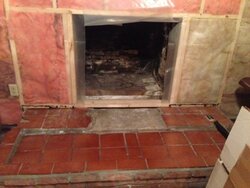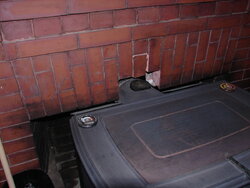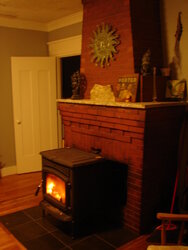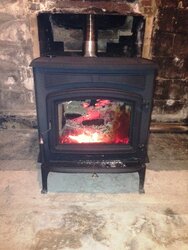Hello everyone,
I have learned a ton from this forum and value the advide of its members. To that end ...
My wife and I just bought a new house a couple months back and the recent cold snap has made me realize that our heating setup really is not sufficient. To sum up, I live in south eastern British Columbia. We get four seasons - summers are warm with temps reaching the 90's, but in winter temperatures are usually below freezing. The house is three levels - basement 1,500 sq ft, main 1430 sq ft, 2nd floor 700 sq ft - so over 3,500 sq ft altogether. The house has a pretty open floor plan which makes heating easier. The entire house has electric baseboard heat - very expensive! I have a masonry style fireplace on the main floor (it has a blower, but is not super efficient as a heat source). There used to be an insert installed in a masonry fireplace in the basement, but the previous owner removed it before we bought the house (I suspect it wasn't up to code). We are getting a natural gas furnace to replace the electric heat, but that won't happen until next spring (can't get a gas line now that everything is frozen). In the mean time, I have convinced the significant other that it's a good idea to have an efficient wood burning appliance of some kind to help us out now and in the future should we need it in an emergency. In truth, I love wood heat, so even once we get a gas furnace I know I'll still be lighting fires.
This is the place (rather unsightly right now) that our new unit would go:

I know that some of the insulation and wood studs would need to be pulled out to give proper clearances. The plan is for us to finish the basement, so that ugly brown hearth has got to go too. The basement walls are insulated (as you can see), but there is no insulation in the floor between the main level and basement. I don't have delusions here that all the heat will rise to the main level, but I'm hoping it will at least make the main floor (hardwood cherry) feel warmer under foot.
Our goals here are:
1. Spend no more than $5,000 for a complete install - looking for good value for dollar here
2. Find a fireplace that will provide a sufficient amount of heat in an emergency (given the sq feet, I think we need something fairly large)
3. Find a fireplace that will look decent in our basement (subjective I know)
I think its a good idea to have a wood stove for cooking too, but my wife doesn't think we would ever use it.
I spoke to the local fireplace store and asked him for some reasonably priced options for a basement install. He gave me a couple, both priced at approx. $5,000 including install of a full chimney liner in our existing masonry chimney and an outide air intake . He is recommending the Jotul F55 as a nice value option for a wood stove, or the Pacific Energy Summit if we want to go the insert route. The dealer said the Jotul has a rear vent option which would make the install a lot easier/cheaper in this case. A top vent stove could be done, but would likely involve coring through the concrete wall into the chimney rather than using the existing opening. I like the Jotul, but my wife prefers the PE. Both look like nice units, so I'm asking the forum members to chime in on any experience with these units and help us decide.
Anyone care to comment on their experience on the heat output of an insert vs a free standing stove of similar size?
Any install concerns that anyone wants to raise for my setup that I should make sure are considered? Thanks everyone ...
I have learned a ton from this forum and value the advide of its members. To that end ...
My wife and I just bought a new house a couple months back and the recent cold snap has made me realize that our heating setup really is not sufficient. To sum up, I live in south eastern British Columbia. We get four seasons - summers are warm with temps reaching the 90's, but in winter temperatures are usually below freezing. The house is three levels - basement 1,500 sq ft, main 1430 sq ft, 2nd floor 700 sq ft - so over 3,500 sq ft altogether. The house has a pretty open floor plan which makes heating easier. The entire house has electric baseboard heat - very expensive! I have a masonry style fireplace on the main floor (it has a blower, but is not super efficient as a heat source). There used to be an insert installed in a masonry fireplace in the basement, but the previous owner removed it before we bought the house (I suspect it wasn't up to code). We are getting a natural gas furnace to replace the electric heat, but that won't happen until next spring (can't get a gas line now that everything is frozen). In the mean time, I have convinced the significant other that it's a good idea to have an efficient wood burning appliance of some kind to help us out now and in the future should we need it in an emergency. In truth, I love wood heat, so even once we get a gas furnace I know I'll still be lighting fires.
This is the place (rather unsightly right now) that our new unit would go:

I know that some of the insulation and wood studs would need to be pulled out to give proper clearances. The plan is for us to finish the basement, so that ugly brown hearth has got to go too. The basement walls are insulated (as you can see), but there is no insulation in the floor between the main level and basement. I don't have delusions here that all the heat will rise to the main level, but I'm hoping it will at least make the main floor (hardwood cherry) feel warmer under foot.
Our goals here are:
1. Spend no more than $5,000 for a complete install - looking for good value for dollar here
2. Find a fireplace that will provide a sufficient amount of heat in an emergency (given the sq feet, I think we need something fairly large)
3. Find a fireplace that will look decent in our basement (subjective I know)
I think its a good idea to have a wood stove for cooking too, but my wife doesn't think we would ever use it.
I spoke to the local fireplace store and asked him for some reasonably priced options for a basement install. He gave me a couple, both priced at approx. $5,000 including install of a full chimney liner in our existing masonry chimney and an outide air intake . He is recommending the Jotul F55 as a nice value option for a wood stove, or the Pacific Energy Summit if we want to go the insert route. The dealer said the Jotul has a rear vent option which would make the install a lot easier/cheaper in this case. A top vent stove could be done, but would likely involve coring through the concrete wall into the chimney rather than using the existing opening. I like the Jotul, but my wife prefers the PE. Both look like nice units, so I'm asking the forum members to chime in on any experience with these units and help us decide.
Anyone care to comment on their experience on the heat output of an insert vs a free standing stove of similar size?
Any install concerns that anyone wants to raise for my setup that I should make sure are considered? Thanks everyone ...








